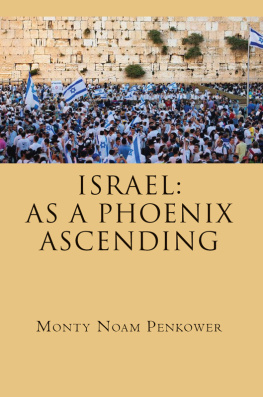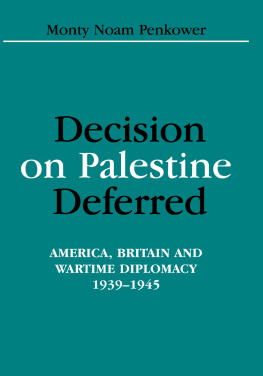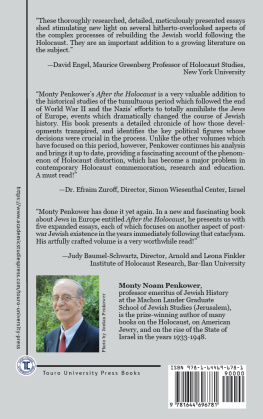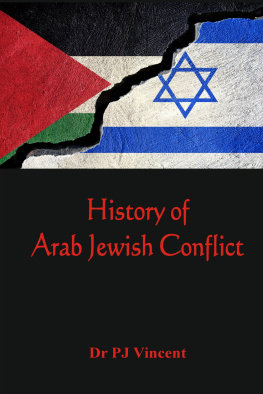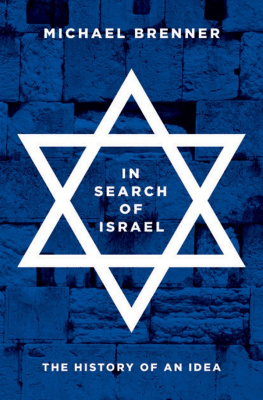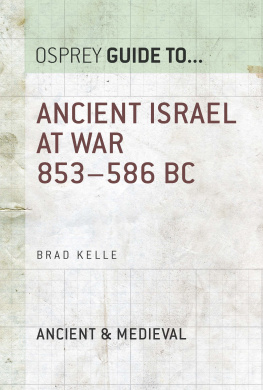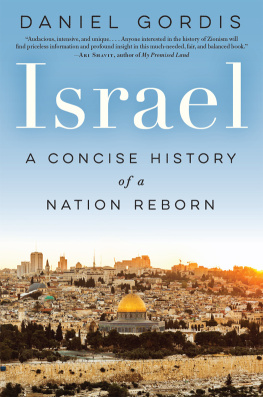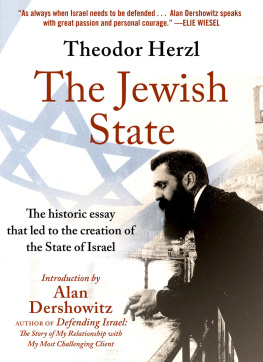

Touro University Press Books
Series Editor
MICHAEL A. SHMIDMAN, PhD (Touro College, New York)
SIMCHA FISHBANE, PhD (Touro College, New York)

Copyright Touro University Press, 2021
Library of Congress Cataloging-in-Publication Data
Names: Penkower, Monty Noam, 1942- author.
Title: Israel : as a phoenix ascending / Monty Noam Penkower.
Description: New York, NY : Touro University Press ; Brookline, MA :
Academic Studies Press, 2021. | Series: Touro University Press books |
Includes bibliographical references and index.
Identifiers: LCCN 2021016924 (print) | LCCN 2021016925 (ebook) | ISBN
9781644696743 (hardback) | ISBN 9781644696750 (paperback) | ISBN
9781644696767 (adobe pdf) | ISBN 9781644696774 (epub)
Subjects: LCSH: Zionism--History. | Israel--History. | Palestine--History.
Classification: LCC DS149 .P4236 2021 (print) | LCC DS149 (ebook) | DDC
956.9405--dc23
LC record available at https://lccn.loc.gov/2021016924
LC ebook record available at https://lccn.loc.gov/2021016925
Published by Touro University Press and Academic Studies Press.
Typeset, printed and distributed by Academic Studies Press.
ISBN 9781644696743 (hardback)
ISBN 9781644696750 (paperback)
ISBN 9781644696767 (adobe pdf)
ISBN 9781644696774 (epub)
Touro University Press
Michael A. Shmidman and Simcha Fishbane, Editors
320 West 31st Street, Fourth Floor,
New York, NY 10001, USA
tcpress@touro.edu
Book design by Kryon Publishing Services.
On the cover: Celebrating Yom Yerushalayim, the liberation of the Old City of Jerusalem by Israeli paratroopers on June 7, 1967, in front of the Western Wall.
Cover design by Ivan Grave.
Academic Studies Press
1577 Beacon Street
Brookline, MA 02446, USA
www.academicstudiespress.com
To Phyllis
Two are better off than one (Ecclesiastes 4:9)
Contents
Preface
Legend has it that the phoenix, a fabulous bird, which periodically regenerated itself, lived in Arabia. When it reached the end of its life at five hundred years, it burned itself on a pyre of flames, and from its ashes a new phoenix arose. As a sacred symbol in the Egyptian religion, beginning with the ancient bennu bird, the phoenix represented the sun, which dies each night and rises again each morning. According to Herodotuss account in the fifth century BCE, the residents of Heliopolis told a story that the bird, whose plumage was a brilliant scarlet and gold (phoenix is the Greek word for crimson, a deep purplish red) and which resembled an eagle came all the way from Arabia, bringing the ashes of the parent bird in a ball of myrrh to deposit them there in the Egyptian Temple of the Sun. The Persian huma, also known as the bird of paradise, was similar to the Egyptian phoenix. The phoenix appeared on the coinage of the late Roman Empire as a symbol of the Eternal City; it also appealed to emergent Christianity and heraldry. Interpreted in Western literature as an allegory of death and resurrection, references to the phoenix surface, among other sources, in Ovids Metamorphoses; Chaucers The Ploughmans Tale; Shakespeares The Tempest, Timon of Athens, and Henry VI; Byrons English and Scotch Reviewers; Shaws Cashel Byrons Profession; and D.H. Lawrences collection of posthumous writings, Phoenix. More recently, it appeared notably in Eudora Weltys short story A Worn Path; Edith Nesbits The Phoenix and the Carpet; Ray Bradburys Fahrenheit 451; and J. K. Rowlings Harry Potter series.
The phoenix is present in Jewish sources as well. The book of Job includes the phrase I shall multiply days as the chol (29:18). A midrash on this biblical text speaks of a chol bird which lives for a thousand years, then dies a fiery red, and is later resurrected from its ashes. According to this midrash, Eve, upset after eating from the forbidden fruit in the
Jacques Lipchitz, the first Cubist sculptor, placed a phoenix atop his last work of art. Toward the end of his life, he had been commissioned by the Hadassah Womens Zionist Organization of America to prepare a sculpture for the Hadassah Hospital on Mt. Scopus in Jerusalem. At his death in 1974, what Lipchitz called The Tree of Life had not been finished. Four years later, the statue was completed by Lipchitzs assistants, under the supervision of his widow. This towering artwork includes depictions of Noah, the sacrifice of Isaac with an angel restraining Abraham, the three Patriarchs, Moses and the burning bush, and a phoenix rising from the burning bush. Lipchitzs phoenix is holding the Ten Commandments. In the renowned artists view, this sculpture represented the history of the Jewish people.
Death and resurrection ( tchiyat hameitim in Hebrew), symbolized by the phoenix, is a core doctrine of traditional Jewish theology. Orthodox Jews believe that during the Messianic Age, the Holy Temple will be rebuilt in Jerusalem, the Jewish people ingathered from the far corners of the earth, and the bodies of the dead brought back to life and reunited with their souls. The rabbinic sages, simplifying the concept of bodily resurrection, posed this analogy: A tree, once alive with blossoms and fruit, full of the sap of life, stands cold and still in the winter. With the coming of spring, God resurrects nature, green leaves appear, and colorful fruits burst from their seed. The most dramatic portrayal of this bodily revival is depicted in the Valley of Dry Bones prophecy in
Arnold J. Toynbee, in his analysis of the rise and fall of twenty-six civilizations in the course of human history, did not think so. As early as 1934, in book one of the eventual twelve-volume A Study of History (19341961), his discussion of Jewish culture began with this sentence: There remains the case where victims of religious discrimination represent an extinct society which only survives as a fossil.... By far the most notable is one of the fossil remnants of the Syriac Society, the Jews. A fossil, in scientific terms, retains its original shape and semblance without the breath of life; its very existence is an anachronism. Two years later, after meeting with Adolf Hitler, Toynbee told British Prime Minister Stanley Baldwin and the Foreign Office that he believed the German Fhrer was sincere in disclaiming any desire to conquer Europe. In the 1950s this erudite research professor of international history at the London School of Economics, a firm believer that history was shaped by spiritual forces, asserted that Jews and Judaism did not fit into any definition of nation, race, or religion. Jews were not a nation because they lived for centuries without a land and the Jewish people were scattered throughout the world. They were not a race because they accepted converts. Nor were they solely a religion, because Jews counted atheists among their numbers. According to Toynbee, the biblical Chosen People, following the spirit of their Hebrew Godprovincial and exclusiveviewed its divine mission with arrogance, not as a burden of obligation to be carried with humility.
The Jewish presence on earth for more than four thousand years notwithstanding, Toynbee was certain that the living Jewish historical drama had come to a halt with the rise of Christianity, when the Jewish people forfeited its political independence in the Land of Israel. With the Fifth and Twelfth Roman legions crushing of the Bar Kokhba Revolt (132135 CE), Jewish futurism died down, a people now relegated to the dustbin of history. Rather than what Joseph B. Soloveitchik, the prime rabbinic voice of Modern Orthodoxy, would later call a developing, destiny-conscious Jewish nation, the British academic, whom many critics considered more of a Christian moralist than a historian, viewed the Jewish people as a mummified community that lived on in
Next page
